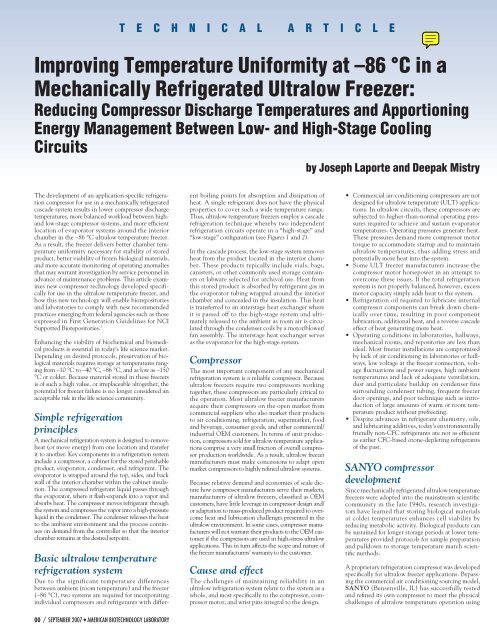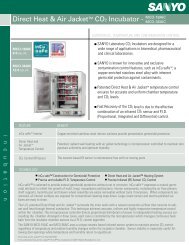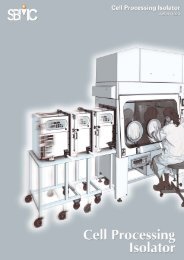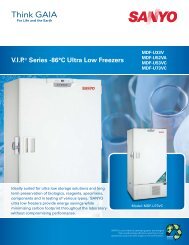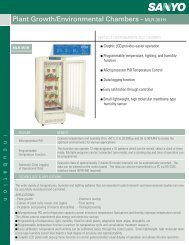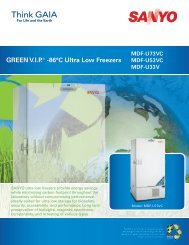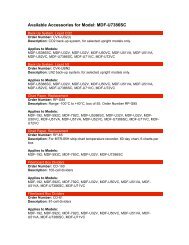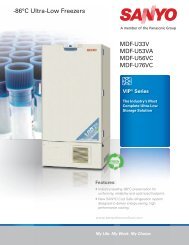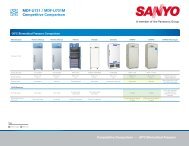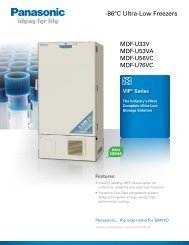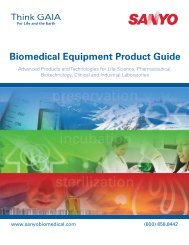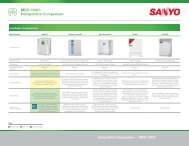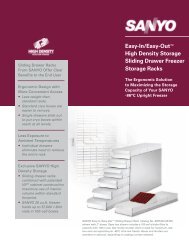Improving Temperature Uniformity at –86 °C in a ... - Biomedical
Improving Temperature Uniformity at –86 °C in a ... - Biomedical
Improving Temperature Uniformity at –86 °C in a ... - Biomedical
Create successful ePaper yourself
Turn your PDF publications into a flip-book with our unique Google optimized e-Paper software.
T E C H N I C A L A R T I C L E<strong>Improv<strong>in</strong>g</strong> <strong>Temper<strong>at</strong>ure</strong> <strong>Uniformity</strong> <strong>at</strong> <strong>–86</strong> <strong>°C</strong> <strong>in</strong> aMechanically Refriger<strong>at</strong>ed Ultralow Freezer:Reduc<strong>in</strong>g Compressor Discharge <strong>Temper<strong>at</strong>ure</strong>s and Apportion<strong>in</strong>gEnergy Management Between Low- and High-Stage Cool<strong>in</strong>gCircuitsby Joseph Laporte and Deepak MistryThe development of an applic<strong>at</strong>ion-specific refriger<strong>at</strong>ioncompressor for use <strong>in</strong> a mechanically refriger<strong>at</strong>edcascade system results <strong>in</strong> lower compressor dischargetemper<strong>at</strong>ures, more balanced workload between highandlow-stage compressor systems, and more efficientloc<strong>at</strong>ion of evapor<strong>at</strong>or systems around the <strong>in</strong>teriorchamber <strong>in</strong> the <strong>–86</strong> <strong>°C</strong> ultralow temper<strong>at</strong>ure freezer.As a result, the freezer delivers better chamber temper<strong>at</strong>ureuniformity necessary for stability of storedproduct, better viability of frozen biological m<strong>at</strong>erials,and more accur<strong>at</strong>e monitor<strong>in</strong>g of oper<strong>at</strong><strong>in</strong>g anomaliesth<strong>at</strong> may warrant <strong>in</strong>vestig<strong>at</strong>ion by service personnel <strong>in</strong>advance of ma<strong>in</strong>tenance problems. This article exam<strong>in</strong>esnew compressor technology developed specificallyfor use <strong>in</strong> the ultralow temper<strong>at</strong>ure freezer, andhow this new technology will enable biorepositoriesand labor<strong>at</strong>ories to comply with new recommendedpractices emerg<strong>in</strong>g from federal agencies such as thoseexpressed <strong>in</strong> First Gener<strong>at</strong>ion Guidel<strong>in</strong>es for NCISupported Biorepositories. 1Enhanc<strong>in</strong>g the viability of biochemical and biomedicalproducts is essential <strong>in</strong> today’s life science market.Depend<strong>in</strong>g on desired protocols, preserv<strong>at</strong>ion of biologicalm<strong>at</strong>erials requires storage <strong>at</strong> temper<strong>at</strong>ures rang<strong>in</strong>gfrom –10 <strong>°C</strong> to –40 <strong>°C</strong>, <strong>–86</strong> <strong>°C</strong>, and as low as –150<strong>°C</strong> or colder. Because m<strong>at</strong>erial stored <strong>in</strong> these freezersis of such a high value, or irreplaceable altogether, thepotential for freezer failure is no longer considered anacceptable risk <strong>in</strong> the life science community.Simple refriger<strong>at</strong>ionpr<strong>in</strong>ciplesA mechanical refriger<strong>at</strong>ion system is designed to removehe<strong>at</strong> (or move energy) from one loc<strong>at</strong>ion and transferit to another. Key components <strong>in</strong> a refriger<strong>at</strong>ion system<strong>in</strong>clude a compressor, a cab<strong>in</strong>et for the stored perishableproduct, evapor<strong>at</strong>or, condenser, and refrigerant. Theevapor<strong>at</strong>or is wrapped around the top, sides, and backwall of the <strong>in</strong>terior chamber with<strong>in</strong> the cab<strong>in</strong>et <strong>in</strong>sul<strong>at</strong>ion.The compressed refrigerant liquid passes throughthe evapor<strong>at</strong>or, where it flash-expands <strong>in</strong>to a vapor andabsorbs he<strong>at</strong>. The compressor moves refrigerant throughthe system and compresses the vapor <strong>in</strong>to a high-pressureliquid <strong>in</strong> the condenser. The condenser releases the he<strong>at</strong>to the ambient environment and the process cont<strong>in</strong>ueson demand from the controller so th<strong>at</strong> the <strong>in</strong>teriorchamber rema<strong>in</strong>s <strong>at</strong> the desired setpo<strong>in</strong>t.Basic ultralow temper<strong>at</strong>urerefriger<strong>at</strong>ion systemDue to the significant temper<strong>at</strong>ure differencesbetween ambient (room temper<strong>at</strong>ure) and the freezer(<strong>–86</strong> <strong>°C</strong>), two systems are required for <strong>in</strong>corpor<strong>at</strong><strong>in</strong>g<strong>in</strong>dividual compressors and refrigerants with differentboil<strong>in</strong>g po<strong>in</strong>ts for absorption and dissip<strong>at</strong>ion ofhe<strong>at</strong>. A s<strong>in</strong>gle refrigerant does not have the physicalproperties to cover such a wide temper<strong>at</strong>ure range.Thus, ultralow temper<strong>at</strong>ure freezers employ a cascaderefriger<strong>at</strong>ion technique whereby two <strong>in</strong>dependentrefriger<strong>at</strong>ion circuits oper<strong>at</strong>e <strong>in</strong> a “high-stage” and“low-stage” configur<strong>at</strong>ion (see Figures 1 and 2).In the cascade process, the low-stage system removeshe<strong>at</strong> from the product loc<strong>at</strong>ed <strong>in</strong> the <strong>in</strong>terior chamber.These products typically <strong>in</strong>clude vials, bags,canisters, or other commonly used storage conta<strong>in</strong>ersor labware selected for archival use. He<strong>at</strong> fromthis stored product is absorbed by refrigerant gas <strong>in</strong>the evapor<strong>at</strong>or tub<strong>in</strong>g wrapped around the <strong>in</strong>teriorchamber and concealed <strong>in</strong> the <strong>in</strong>sul<strong>at</strong>ion. This he<strong>at</strong>is transferred to an <strong>in</strong>terstage he<strong>at</strong> exchanger whereit is passed off to the high-stage system and ultim<strong>at</strong>elyreleased to the ambient as room air is circul<strong>at</strong>edthrough the condenser coils by a motor/blower/fan assembly. The <strong>in</strong>terstage he<strong>at</strong> exchanger servesas the evapor<strong>at</strong>or for the high-stage system.CompressorThe most important component of any mechanicalrefriger<strong>at</strong>ion system is a reliable compressor. Becauseultralow freezers require two compressors work<strong>in</strong>gtogether, these compressors are particularly critical tothe oper<strong>at</strong>ion. Most ultralow freezer manufacturersacquire their compressors on the open market fromcommercial suppliers who also market their productsto air condition<strong>in</strong>g, refriger<strong>at</strong>ion, supermarket, foodand beverage, consumer goods, and other commercial/<strong>in</strong>dustrial OEM customers. In terms of unit production,compressors sold for ultralow temper<strong>at</strong>ure applic<strong>at</strong>ionscomprise a very small fraction of overall compressorproduction worldwide. As a result, ultralow freezermanufacturers must make concessions to adapt openmarket compressors to highly ref<strong>in</strong>ed ultralow systems.Because rel<strong>at</strong>ive demand and economies of scale dict<strong>at</strong>ehow compressor manufacturers serve their markets,manufacturers of ultralow freezers, classified as OEMcustomers, have little leverage <strong>in</strong> compressor design and/or adapt<strong>at</strong>ion to mass-produced product required to overcomehe<strong>at</strong> and lubric<strong>at</strong>ion challenges presented <strong>in</strong> theultralow environment. In some cases, compressor manufacturerswill not warrant their products to the OEM customerif the compressors are used <strong>in</strong> high-stress ultralowapplic<strong>at</strong>ions. This <strong>in</strong> turn affects the scope and n<strong>at</strong>ure ofthe freezer manufacturers’ warranty to the customer.Cause and effectThe challenges of ma<strong>in</strong>ta<strong>in</strong><strong>in</strong>g reliability <strong>in</strong> anultralow refriger<strong>at</strong>ion system rel<strong>at</strong>e to the system as awhole, and most specifically to the compressor, compressormotor, and wrist p<strong>in</strong>s <strong>in</strong>tegral to the design.• Commercial air-condition<strong>in</strong>g compressors are notdesigned for ultralow temper<strong>at</strong>ure (ULT) applic<strong>at</strong>ions.In ultralow circuits, these compressors aresubjected to higher-than-normal oper<strong>at</strong><strong>in</strong>g pressuresrequired to achieve and susta<strong>in</strong> evapor<strong>at</strong>ortemper<strong>at</strong>ures. Oper<strong>at</strong><strong>in</strong>g pressures gener<strong>at</strong>e he<strong>at</strong>.These pressures demand more compressor motortorque to accommod<strong>at</strong>e startup and to ma<strong>in</strong>ta<strong>in</strong>ultralow temper<strong>at</strong>ures, thus add<strong>in</strong>g stress andpotentially more he<strong>at</strong> <strong>in</strong>to the system.• Some ULT freezer manufacturers <strong>in</strong>crease thecompressor motor horsepower <strong>in</strong> an <strong>at</strong>tempt toovercome these issues. If the total refriger<strong>at</strong>ionsystem is not properly balanced, however, excessmotor capacity simply adds he<strong>at</strong> to the system.• Refriger<strong>at</strong>ion oil required to lubric<strong>at</strong>e <strong>in</strong>ternalcompressor components can break down chemicallyover time, result<strong>in</strong>g <strong>in</strong> poor componentlubric<strong>at</strong>ion, additional he<strong>at</strong>, and a reverse cascadeeffect of he<strong>at</strong> gener<strong>at</strong><strong>in</strong>g more he<strong>at</strong>.• Oper<strong>at</strong><strong>in</strong>g conditions <strong>in</strong> labor<strong>at</strong>ories, hallways,mechanical rooms, and repositories are less thanideal. Most freezer <strong>in</strong>stall<strong>at</strong>ions are compromisedby lack of air condition<strong>in</strong>g <strong>in</strong> labor<strong>at</strong>ories or hallways,low voltage <strong>at</strong> the freezer connection, voltagefluctu<strong>at</strong>ions and power surges, high ambienttemper<strong>at</strong>ures and lack of adequ<strong>at</strong>e ventil<strong>at</strong>ion,dust and particul<strong>at</strong>e buildup on condenser f<strong>in</strong>ssurround<strong>in</strong>g condenser tub<strong>in</strong>g, frequent freezerdoor open<strong>in</strong>gs, and poor technique such as <strong>in</strong>troductionof large amounts of warm or room temper<strong>at</strong>ureproduct without prefreez<strong>in</strong>g.• Despite advances <strong>in</strong> refrigerant chemistry, oils,and lubric<strong>at</strong><strong>in</strong>g additives, today’s environmentallyfriendly non-CFC refrigerants are not as efficientas earlier CFC-based ozone-deplet<strong>in</strong>g refrigerantsof the past.SANYO compressordevelopmentS<strong>in</strong>ce mechanically refriger<strong>at</strong>ed ultralow temper<strong>at</strong>urefreezers were adopted <strong>in</strong>to the ma<strong>in</strong>stream scientificcommunity <strong>in</strong> the l<strong>at</strong>e 1940s, research <strong>in</strong>vestig<strong>at</strong>orshave learned th<strong>at</strong> stor<strong>in</strong>g biological m<strong>at</strong>erials<strong>at</strong> colder temper<strong>at</strong>ures enhances cell viability byreduc<strong>in</strong>g metabolic activity. Biological products canbe susta<strong>in</strong>ed for longer storage periods <strong>at</strong> lower temper<strong>at</strong>uresprovided protocols for sample prepar<strong>at</strong>ionand pulldown to storage temper<strong>at</strong>ure m<strong>at</strong>ch scientificmethods.A proprietary refriger<strong>at</strong>ion compressor was developedspecifically for ultralow freezer applic<strong>at</strong>ions. Bypass<strong>in</strong>gthe commercial air condition<strong>in</strong>g sourc<strong>in</strong>g model,SANYO (Bensenville, IL) has successfully testedand ref<strong>in</strong>ed its own compressor to meet the physicalchallenges of ultralow temper<strong>at</strong>ure oper<strong>at</strong>ion us<strong>in</strong>g00 / SEPTEMBER 2007 • AMERICAN BIOTECHNOLOGY LABORATORY
T E C H N I C A L A R T I C L EFigure 1 The SANYO cascade refriger<strong>at</strong>ion system employs two<strong>in</strong>dependent refriger<strong>at</strong>ion circuits <strong>in</strong>directly connected by an <strong>in</strong>terstagehe<strong>at</strong> exchanger. The company’s proprietary <strong>in</strong>tegr<strong>at</strong>ed lubric<strong>at</strong><strong>in</strong>g oilcool<strong>in</strong>gsystem (p<strong>at</strong>ent pend<strong>in</strong>g) autom<strong>at</strong>ically apportions the workloadbetween compressors and permits both compressors to oper<strong>at</strong>e well with<strong>in</strong>the expanded performance envelope. 1) Freezer cab<strong>in</strong>et with evapor<strong>at</strong>or:The evapor<strong>at</strong>or coil is str<strong>at</strong>egically wrapped around the <strong>in</strong>terior chamberand concealed with<strong>in</strong> the composite wall of vacuum <strong>in</strong>sul<strong>at</strong>ion panelsand conventional foamed-<strong>in</strong>-place urethane <strong>in</strong>sul<strong>at</strong>ion. 2) Low-stagehe<strong>at</strong> exchanger: Energy is absorbed by the refrigerant gas and transferredto the low-stage he<strong>at</strong> exchanger to cool discharge gas. 3) Low-stagecompressor: The compressor pumps refrigerant through the low-stagecircuit. 4) Low-stage oil reservoir: High-stage refrigerant passes throughthe low-stage oil sump to cool lubric<strong>at</strong><strong>in</strong>g oil, result<strong>in</strong>g <strong>in</strong> high-stagecompressor energy be<strong>in</strong>g used to m<strong>in</strong>imize the workload on the low-stagecompressor. 5) Interstage he<strong>at</strong> exchanger: Energy is transferred to thehigh-stage circuit. 6) Low-stage capillary tube: Liquid refrigerant underpressure is passed through the capillary tube where it flash-evapor<strong>at</strong>es <strong>in</strong>the low-stage evapor<strong>at</strong>or to absorb energy (he<strong>at</strong>) from the product stored<strong>in</strong> the freezer. 7) High-stage compressor: The compressor pumps refrigerantthrough the high-stage circuit. 8) High-stage oil reservoir: High-stagerefrigerant passes through the high-stage sump to cool lubric<strong>at</strong><strong>in</strong>g oil enroute to the low-stage compressor through the air-cooled precondenser.9) Air-cooled precondenser: Removes energy (he<strong>at</strong>) from the high-stagerefrigerant en route to the low-stage compressor. 10) Ma<strong>in</strong> condenserand motor/fan assembly: The motor/fan assembly blows ambient airacross condenser coils to move energy (he<strong>at</strong>) from the high-stage refrigerantto the ambient environment. 11) High-stage capillary tube: Liquidrefrigerant under pressure is passed through the capillary tube where itflash-evapor<strong>at</strong>es <strong>in</strong> the <strong>in</strong>terstage he<strong>at</strong> exchanger to absorb energy (he<strong>at</strong>)from the low-stage refrigerant circuit. 12) Air-cooled precondenser:Removes energy (he<strong>at</strong>) from the high-stage refrigerant en route to thehigh-stage oil reservoir. 13) High-stage refrigerant: Commonly availableworldwide. A comb<strong>in</strong><strong>at</strong>ion of R134a and R410a (Puron ® ) selected foroptimum cool<strong>in</strong>g performance <strong>in</strong> compliance with <strong>in</strong>tern<strong>at</strong>ional environmentalprotection laws. 14) Low-stage refrigerant: Commonly availableworldwide, R508. 15) Instrument<strong>at</strong>ion (not shown): <strong>Temper<strong>at</strong>ure</strong> andpressure sensors throughout the high- and low-stage circuits transmit<strong>in</strong>form<strong>at</strong>ion to the St<strong>at</strong>us 3 central controller for oper<strong>at</strong>ion, monitor<strong>in</strong>g,and <strong>in</strong>terpret<strong>at</strong>ion.new, environmentally safe refrigerants. Collabor<strong>at</strong><strong>in</strong>gwith <strong>in</strong>dustry leaders <strong>in</strong> refriger<strong>at</strong>ion chemistry,lubric<strong>at</strong>ion p<strong>at</strong>hways, n<strong>at</strong>ural and synthetic oils, andcab<strong>in</strong>et <strong>in</strong>sul<strong>at</strong>ion technologies, SANYO eng<strong>in</strong>eershave cre<strong>at</strong>ed a highly reliable ultralow temper<strong>at</strong>urefreezer based on the performance of compressorsdo<strong>in</strong>g the work they were specificallydesigned to do.Cab<strong>in</strong>et designprerequisitesConcurrent with refriger<strong>at</strong>ion system research,SANYO pioneered the development of a compositecab<strong>in</strong>et wall based on a comb<strong>in</strong><strong>at</strong>ion ofconventional, high-density foamed-<strong>in</strong>-place<strong>in</strong>sul<strong>at</strong>ion and new, st<strong>at</strong>e-of-the-art vacuum<strong>in</strong>sul<strong>at</strong>ion panels (SANYO VIP ® , U.S. p<strong>at</strong>entno. 6,260,377) permitt<strong>in</strong>g a th<strong>in</strong>ner wall profileand <strong>in</strong>creased <strong>in</strong>terior volume. This design optimizesuse of available labor<strong>at</strong>ory space by allow<strong>in</strong>gmore storage <strong>in</strong> the same footpr<strong>in</strong>t.S<strong>in</strong>ce the orig<strong>in</strong>al VIP design was <strong>in</strong>troduced,company researchers developed proprietaryimprovements <strong>in</strong> the open cell panel technique,cre<strong>at</strong><strong>in</strong>g better m<strong>at</strong>rices to support a susta<strong>in</strong>ablevacuum, and giv<strong>in</strong>g manufactur<strong>in</strong>g eng<strong>in</strong>eersmore l<strong>at</strong>itude <strong>in</strong> composite orient<strong>at</strong>ion withconventional foam. As a result, evapor<strong>at</strong>or coilswith<strong>in</strong> the th<strong>in</strong>-wall cab<strong>in</strong>et are arranged foroptimal <strong>in</strong>terior uniformity and best he<strong>at</strong> removal(energy transfer), further reduc<strong>in</strong>g the burden onthe cascade refriger<strong>at</strong>ion system. A byproductof the design permits a hot gas bypass to circul<strong>at</strong>earound the peripheral edges of the cab<strong>in</strong>etdoor gasket, warm<strong>in</strong>g the gasket to mitig<strong>at</strong>e thebuildup of moisture to prevent ice form<strong>at</strong>ion ormold on external services (see Table 1).Vertical component<strong>in</strong>tegr<strong>at</strong>ionThe concept of vertical component <strong>in</strong>tegr<strong>at</strong>ionis central to the company’s entire product l<strong>in</strong>e.SANYO manufactures its own oil separ<strong>at</strong>ors,circuit boards, and vacuum <strong>in</strong>sul<strong>at</strong>ion panels,and designs its own compressors. This <strong>in</strong>tegr<strong>at</strong>edsupply cha<strong>in</strong> ensures component quality fromsource to applic<strong>at</strong>ion, and permits the companyto evalu<strong>at</strong>e and improve its own componentswithout third-party <strong>in</strong>volvement.Together with other refriger<strong>at</strong>ion system componentssuch as filter dryers, he<strong>at</strong> exchanges,condenser and evapor<strong>at</strong>or tub<strong>in</strong>g, meter<strong>in</strong>gdevices, motor w<strong>in</strong>d<strong>in</strong>gs, and sophistic<strong>at</strong>edmicroprocessor-based electronic controls, thecompany has cre<strong>at</strong>ed a holistic solution to biologicalpreserv<strong>at</strong>ion.Key compressor componentsEach component of the SANYO compressorhas been electronically designed and modeled<strong>in</strong> stereolithographic beta form to exceedactual oper<strong>at</strong><strong>in</strong>g conditions. Pistons, connect<strong>in</strong>garms, valve pl<strong>at</strong>es, and wrist p<strong>in</strong>s aredesigned to handle high load capacities. Alltest<strong>in</strong>g is performed <strong>in</strong> a +35 <strong>°C</strong> ambient.*Proper delivery and return of lubricants is a key factor<strong>in</strong> extend<strong>in</strong>g component life. Compressor motor siz<strong>in</strong>gis predic<strong>at</strong>ed on refrigerant flow as well as energyrequired for <strong>in</strong>itial pull-down, and then susta<strong>in</strong>edultralow temper<strong>at</strong>ure with reserve capacity. Motorw<strong>in</strong>d<strong>in</strong>gs are configured to accommod<strong>at</strong>e fluctu<strong>at</strong><strong>in</strong>gelectrical supplies <strong>in</strong> many <strong>in</strong>stitutional sett<strong>in</strong>gs. Atthe same time, SANYO’s commitment to “greenproducts” is expressed through more efficient motoroper<strong>at</strong>ion with reduced energy consumption.A better compressor yieldsbetter uniformity andimproved reliabilityHe<strong>at</strong> from multiple sources contributes to compressorwear. He<strong>at</strong> is gener<strong>at</strong>ed by compressors work<strong>in</strong>g tocompress low-density refrigerants required <strong>in</strong> the lowstage of the cascade loop. Additional he<strong>at</strong> is absorbedby room-temper<strong>at</strong>ure product placed <strong>in</strong>to the freezer,as well as migr<strong>at</strong>ion from the ambient environment.In the SANYO research and development labor<strong>at</strong>ory,prototype compressors were tested under harshenvironmental conditions to exceed actual freezeruse <strong>in</strong> typical labor<strong>at</strong>ories. Because the companycontrols its own compressor design, all amendmentsand reeng<strong>in</strong>eer<strong>in</strong>g options were explored as needed,with new prototypes brought <strong>in</strong>to test quickly. Lifetest<strong>in</strong>g and tear-downs delivered critical d<strong>at</strong>a toSANYO eng<strong>in</strong>eers, permitt<strong>in</strong>g beta test results to besynthesized <strong>in</strong>to the complete design program <strong>in</strong> supportof the global ultralow freezer program.Design mand<strong>at</strong>e: reducedischarge temper<strong>at</strong>ureThe ultralow temper<strong>at</strong>ure compressor employs anorient<strong>at</strong>ion of conventional components to reducedischarge temper<strong>at</strong>ures and compressor he<strong>at</strong> whileus<strong>in</strong>g commercially available refrigerants and lubricants.He<strong>at</strong> reduction results range from as low as 25<strong>°C</strong> below previous SANYO compressors and morethan 40 <strong>°C</strong> below lead<strong>in</strong>g-brand compressors used bynumerous competitors.At the heart of the solution is a compressor oilcool<strong>in</strong>gloop th<strong>at</strong> reapportions the work<strong>in</strong>g he<strong>at</strong>byproduct between the low-stage compressor and thehigh-stage compressor. Due to low molecular weights<strong>in</strong> low-stage refrigerant formul<strong>at</strong>ions, low-stage compressorsmust work harder to achieve cool<strong>in</strong>g targets.The SANYO technique uses exist<strong>in</strong>g lubric<strong>at</strong><strong>in</strong>g oilto cool the low-stage compressor, pass<strong>in</strong>g the result<strong>in</strong>ghe<strong>at</strong> load to the high-stage compressor, which,by design, is already do<strong>in</strong>g less work.By shift<strong>in</strong>g a portion of the burden from the lowstage to the high stage, the load on both compressorsis balanced while reduc<strong>in</strong>g oper<strong>at</strong><strong>in</strong>g pressuresand keep<strong>in</strong>g he<strong>at</strong> loads and discharge temper<strong>at</strong>ureswell with<strong>in</strong> tolerances required to prevent chemicalbreakdown of oils and refrigerants. As a result,refriger<strong>at</strong>ion capacity is expanded and structuraleng<strong>in</strong>eers have more l<strong>at</strong>itude <strong>in</strong> str<strong>at</strong>egic applic<strong>at</strong>ionof evapor<strong>at</strong>or coils around the <strong>in</strong>terior chamber, akey to temper<strong>at</strong>ure uniformity and, ultim<strong>at</strong>ely, tocell viability.Apply<strong>in</strong>g the benefitWith lower compressor discharge temper<strong>at</strong>ures and pressures,newer refrigerants can be more effective. Comb<strong>in</strong>edwith VIP <strong>in</strong>sul<strong>at</strong>ion, the migr<strong>at</strong>ion of ambient*Test<strong>in</strong>g and evalu<strong>at</strong>ion: Consumer Advisory Performance test<strong>in</strong>g and published d<strong>at</strong>a on SANYO ultralow temper<strong>at</strong>ure freezers is based on extensive test<strong>in</strong>g <strong>in</strong> a +35 <strong>°C</strong> ambient to simul<strong>at</strong>e worstcaseconditions. When compar<strong>in</strong>g performance of competitive ultralow freezers, it is important to establish and verify conditions under which tests are performed. Tests performed <strong>at</strong> temper<strong>at</strong>uresbelow +35 <strong>°C</strong> may exhibit lower compressor discharge temper<strong>at</strong>ures; these discharge temper<strong>at</strong>ures are not typical of real-world conditions, however, and should be used with caution when evalu<strong>at</strong><strong>in</strong>gnew or replacement freezer selection. For summary <strong>in</strong>form<strong>at</strong>ion on test conditions contact SANYO (Table 2).00 / SEPTEMBER 2007 • AMERICAN BIOTECHNOLOGY LABORATORY
T E C H N I C A L A R T I C L EIf a condition self-corrects (as most do <strong>in</strong> highly fluctu<strong>at</strong><strong>in</strong>genvironments), the signal will switch off. Ifthe condition persists, however, the signal will notifythe user th<strong>at</strong> a professional assessment of freezer performanceis required. Often, this assessment can be<strong>in</strong>iti<strong>at</strong>ed by a quick query of on-board d<strong>at</strong>a from thecontroller, conducted by <strong>in</strong>-house facilities ma<strong>in</strong>tenancepersonnel familiar with standard ultralowfreezer oper<strong>at</strong>ions.Figure 2Ultralow refriger<strong>at</strong>ion system benefits.Table 1 Comparison chart: uniformity/noisePerformance SANYO Brand N Brand R Brand F<strong>Temper<strong>at</strong>ure</strong> uniformity 4.2 <strong>°C</strong> 9.0 <strong>°C</strong> 12.5 <strong>°C</strong> 7.7 <strong>°C</strong>range (setpo<strong>in</strong>t @ –80 <strong>°C</strong>)<strong>Temper<strong>at</strong>ure</strong>, top of chamber <strong>–86</strong>.0 <strong>°C</strong> –77.5 <strong>°C</strong> –81.4 <strong>°C</strong> –81.4 <strong>°C</strong>(setpo<strong>in</strong>t @ <strong>–86</strong> <strong>°C</strong>)Maximum warm<strong>in</strong>g po<strong>in</strong>t –75.0 <strong>°C</strong> –34.3 <strong>°C</strong> –57.7 <strong>°C</strong> –76.8 <strong>°C</strong>(10-sec door open<strong>in</strong>g)Noise level (1 meter from unit) 43.8 dB(A) 51.7 dB(A) 52.0 dB(A) 72.0 dB(A)Storage volume efficiency 2.7 cu. ft./sq. ft. 2.67 cu. ft./sq. ft. 2.28 cu. ft./sq. ft. 2.19 cu. ft./sq. ft.(volume/sq. ft. floor space)Table 2 SANYO ultralow temper<strong>at</strong>ure freezer test<strong>in</strong>g protocolAmbient temper<strong>at</strong>ure +35 <strong>°C</strong>. Important: Performance test<strong>in</strong>g and published d<strong>at</strong>a on SANYO ultralowdur<strong>in</strong>g testtemper<strong>at</strong>ure freezers are based on extensive test<strong>in</strong>g <strong>in</strong> a +35 <strong>°C</strong> ambient to simul<strong>at</strong>eworst-case conditions. When compar<strong>in</strong>g performance of competitive ultralowfreezers, it is important to establish and verify conditions under which tests areperformed. Tests performed <strong>at</strong> temper<strong>at</strong>ures below +35 <strong>°C</strong> may exhibit lowercompressor discharge temper<strong>at</strong>ures; these discharge temper<strong>at</strong>ures are not typical ofreal-world conditions, however, and should be used with caution when evalu<strong>at</strong><strong>in</strong>gnew or replacement freezer selection. For summary <strong>in</strong>form<strong>at</strong>ion on test conditionscontact SANYO.Voltage range dur<strong>in</strong>g test Variable. For 220 V ac, 60-Hz models test<strong>in</strong>g is conducted over voltage rangesstart<strong>in</strong>g as low as 202 V to simul<strong>at</strong>e brown-out conditions typical of real-world<strong>in</strong>stall<strong>at</strong>ions.Freezer load dur<strong>in</strong>g test Variable. Thermal mass of a fully loaded freezer <strong>at</strong> equilibrium under normalultralow temper<strong>at</strong>ures yields the best performance d<strong>at</strong>a. SANYO freezers are testedunder empty, half-load, and full-load conditions.he<strong>at</strong> from the labor<strong>at</strong>ory to the <strong>in</strong>terior is m<strong>in</strong>imized.Evapor<strong>at</strong>or wrapp<strong>in</strong>g concealed with<strong>in</strong> the compositewall is wrapped around the <strong>in</strong>terior chamber to achievebest energy transfer and leverage common physical propertiesof cold air density with<strong>in</strong> the storage area.Smart refriger<strong>at</strong>ionmonitor<strong>in</strong>g systemWhile compressor improvements have led tomore efficient refriger<strong>at</strong>ion performance, SANYOeng<strong>in</strong>eers have tapped the company’s extensiveresources <strong>in</strong> electronics and controls to develop theSt<strong>at</strong>us 3 control, alarm, and security system. Morethan just a controller, the system collects <strong>in</strong>ternald<strong>at</strong>a from waypo<strong>in</strong>ts deep with<strong>in</strong> the cascade refriger<strong>at</strong>ionsystem, and processes this <strong>in</strong>form<strong>at</strong>ion bycompar<strong>in</strong>g to norm<strong>at</strong>ive values written to the onboardalgorithm. This cont<strong>in</strong>uous, self-diagnosticprotocol is autom<strong>at</strong>ic. If values range beyond thosewritten to the factory-based performance permissions,the freezer will display an advisory signal onthe ma<strong>in</strong> control panel.St<strong>at</strong>us 3 functions1. High ambient conditions• The St<strong>at</strong>us 3 system tracks high ambient (roomor hallway) conditions th<strong>at</strong> can occur periodically,but are not recommended for long-termoper<strong>at</strong>ion. These usually constitute ambienttemper<strong>at</strong>ures <strong>at</strong> or above +35 <strong>°C</strong>. Repe<strong>at</strong>edexcessive ambient read<strong>in</strong>gs will activ<strong>at</strong>e thewarn<strong>in</strong>g and the user must <strong>in</strong>vestig<strong>at</strong>e thereason for the high ambient condition. TheSANYO freezer will cont<strong>in</strong>ue to function, butsubject<strong>in</strong>g the freezer to extreme ambient conditionsresults <strong>in</strong> longer refriger<strong>at</strong>ion run timeand higher energy costs.2. Low voltage• Low voltage is common <strong>in</strong> many labor<strong>at</strong>oriesdue to <strong>in</strong>creased power demand <strong>in</strong> cl<strong>in</strong>icaland research environments, drug discovery,storage, and process<strong>in</strong>g. These conditions aremost common <strong>in</strong> older <strong>in</strong>stitutions or thoseth<strong>at</strong> have been retrofitted for labor<strong>at</strong>ory use.• Often, freezer users mistakenly assume th<strong>at</strong>proper power (120 V or 208/230 V) is readilyavailable and susta<strong>in</strong>able <strong>at</strong> the wall electricaloutlet. Often, however, supply voltageis err<strong>at</strong>ic and usually lower than desired forproper freezer oper<strong>at</strong>ion. The St<strong>at</strong>us 3 detectslow voltage and warns the user through thefreezer control panel monitor<strong>in</strong>g system.When this notific<strong>at</strong>ion occurs, build<strong>in</strong>g ma<strong>in</strong>tenanceor facilities eng<strong>in</strong>eer<strong>in</strong>g personnelshould be contacted to <strong>in</strong>vestig<strong>at</strong>e the issue.• To protect the valuable stored product, SANYOultralow freezers with voltage enhancementsystems will autom<strong>at</strong>ically correct the voltagethrough an <strong>in</strong>ternal transformer and boost thevoltage to the proper level.Run time d<strong>at</strong>aHigh ambient temper<strong>at</strong>ures, numerous or prolongeddoor open<strong>in</strong>gs, and <strong>in</strong>troduction of warm or roomtemper<strong>at</strong>ureproduct <strong>in</strong>to the freezer storage compartmentcan cause prolonged refriger<strong>at</strong>ion systemrun time. The St<strong>at</strong>us 3 monitors compressor run timeand performs diagnostics based on ambient temper<strong>at</strong>ures,door open<strong>in</strong>gs, voltage, and other usage factors.If the low-stage compressor run time is <strong>in</strong>ord<strong>in</strong><strong>at</strong>elyhigh, the St<strong>at</strong>us 3 will notify the user th<strong>at</strong> thesystem and <strong>in</strong>stall<strong>at</strong>ion should be reviewed. Thesecalcul<strong>at</strong>ions are based on the follow<strong>in</strong>g:• Length of time from previous door open<strong>in</strong>g• Oper<strong>at</strong><strong>in</strong>g time below setpo<strong>in</strong>t• Ambient temper<strong>at</strong>ure.In simple terms, the freezer senses when it is overloadedor oper<strong>at</strong><strong>in</strong>g under stress. The St<strong>at</strong>us 3 warn<strong>in</strong>gsystem will alert the user of this condition <strong>in</strong>advance of any pend<strong>in</strong>g performance issues.Compressor run time/powerconsumptionThe SANYO ultralow system employs a high-stage andlow-stage compressor controlled by the St<strong>at</strong>us 3 micro-00 / SEPTEMBER 2007 • AMERICAN BIOTECHNOLOGY LABORATORY
T E C H N I C A L A R T I C L Eprocessor control system. By design, the high-stage compressorruns 100% of the time, permitt<strong>in</strong>g the low-stagecompressor to cycle on demand for cool<strong>in</strong>g from the<strong>in</strong>terior chamber, reduc<strong>in</strong>g high head pressures on thelow-stage system, permitt<strong>in</strong>g easier startup and reduc<strong>in</strong>genergy demand. S<strong>in</strong>ce conventional cascade refriger<strong>at</strong>ionsystems cycle both systems on and off, the high- andlow-stage compressors must “step start” nearly simultaneouslyor with a slight delay. This requires a high powerdemand for two systems to start, and can trip a circuitbreaker dur<strong>in</strong>g periods of high electrical demand.The phenomenon of high-temper<strong>at</strong>ure “<strong>in</strong>-rush currents”over time can weaken and degrade compressorw<strong>in</strong>d<strong>in</strong>gs, result<strong>in</strong>g <strong>in</strong> compressor failure. SANYOcompressors fe<strong>at</strong>ure oversized w<strong>in</strong>d<strong>in</strong>gs designed toanticip<strong>at</strong>e and accommod<strong>at</strong>e <strong>in</strong>-rush currents with<strong>in</strong>the normal performance envelope to mitig<strong>at</strong>e compressordegrad<strong>at</strong>ion due to frequent startups.Th<strong>in</strong>k<strong>in</strong>g green, th<strong>in</strong>k<strong>in</strong>gsafe*SANYO is conscious of the need to protect our environmentand conserve energy. As a corpor<strong>at</strong>e pioneer<strong>in</strong> life science labor<strong>at</strong>ory equipment and appliances,and as a global source of solutions rang<strong>in</strong>g from energymanagement to solar power and altern<strong>at</strong>ive energies,the company rema<strong>in</strong>s committed to provid<strong>in</strong>g thebest possible labor<strong>at</strong>ory equipment for research andcl<strong>in</strong>ical needs. This commitment was demonstr<strong>at</strong>edwhen it took the <strong>in</strong>iti<strong>at</strong>ive to revamp and redesignnewer refriger<strong>at</strong>ion systems th<strong>at</strong> would employ new,environmentally friendly refrigerants throughout thelabor<strong>at</strong>ory without compromis<strong>in</strong>g performance.1. CFC-free refrigerants• SANYO was the first ultralow freezer manufacturerto employ non-HCFC R508 lowstagerefrigerant, now recognized as today’s<strong>in</strong>dustry standard and widely available.This nonproprietary refrigerant is availableto refriger<strong>at</strong>ion service professionals on theopen market.• The high-stage refriger<strong>at</strong>ion system is a mixtureof R134a and R410a (Puron), availableto refriger<strong>at</strong>ion professionals on the openmarket as well.2. RoHS compliance• In 2006, RoHS (Restriction of HazardousSubstances) legisl<strong>at</strong>ion (EU Directive2003/95/EU) became effective. RoHS rel<strong>at</strong>esto the restriction of hazardous substances andreductions <strong>in</strong> environmental pollution.• Through RoHS legisl<strong>at</strong>ion, the EU and otherparticip<strong>at</strong><strong>in</strong>g countries are bann<strong>in</strong>g toxicsubstances <strong>in</strong> electrical equipment such aslead, cadmium, mercury, chromium 6+, polybrom<strong>in</strong><strong>at</strong>edbiphenyls (PBBs), and polybrom<strong>in</strong><strong>at</strong>eddiphenyl ethers (PBDEs).• While compliance with this legisl<strong>at</strong>ion hasposed a significant challenge for SANYO, allof its ultralow freezers and components arenow 100% compliant to RoHS standards.3. Electrical standards• All SANYO products, <strong>in</strong>clud<strong>in</strong>g ultralowtemper<strong>at</strong>ure freezers, are tested and certifiedby Entela 2 NRTL (N<strong>at</strong>ional Recognized Test<strong>in</strong>gLabor<strong>at</strong>ory) to ensure compliance withU.S. and <strong>in</strong>tern<strong>at</strong>ional standards for electricalsafety prescribed <strong>in</strong> 29 CFR 1910.7(c).SANYO has selected Entela for <strong>in</strong>dependenttest<strong>in</strong>g to acceler<strong>at</strong>e test<strong>in</strong>g on new productswhile ma<strong>in</strong>ta<strong>in</strong><strong>in</strong>g the highest standards forquality, safety, and performance.4. Noise reduction• Ultralow freezers are often loc<strong>at</strong>ed with<strong>in</strong>research and hospital labor<strong>at</strong>ories or productionfacilities. Users prefer close proximity foreasy access to valuable stored products.• If oper<strong>at</strong><strong>in</strong>g noise from refriger<strong>at</strong>ion compressorsis excessive and/or compoundedby <strong>in</strong>stall<strong>at</strong>ion of multiple freezers <strong>in</strong> adjacentloc<strong>at</strong>ions, the work<strong>in</strong>g environment isseverely compromised.• SANYO has <strong>in</strong>cluded advanced noise ab<strong>at</strong>ement<strong>in</strong> all contemporary ultralow freezersand noise reduction levels are well belowthose of competitive freezers. (D<strong>at</strong>a are availableupon request.)5. Inventory management• Those familiar with the technical designof the SANYO ultralow freezer can draw aquick connection between lower compressordischarge temper<strong>at</strong>ures and better, more efficient<strong>in</strong>ventory management.• Because benefits of the SANYO compressordesign extend to evapor<strong>at</strong>or tub<strong>in</strong>g surround<strong>in</strong>gthe <strong>in</strong>terior chamber, and the <strong>in</strong>terior chamber ispart of the th<strong>in</strong>-wall composite based on the p<strong>at</strong>entedVIP cab<strong>in</strong>et, the company can offer moreuseable storage volume with<strong>in</strong> the same squarefootage of floor space than competitive models.• The concept of high-density storage isenabled by advances <strong>in</strong> SANYO compressordesign. The cost per cubic foot (or liter) of<strong>in</strong>terior storage space is significantly lower<strong>in</strong> a SANYO ultralow freezer, gener<strong>at</strong><strong>in</strong>gimmedi<strong>at</strong>e return on <strong>in</strong>vestment based onfirst costs, oper<strong>at</strong><strong>in</strong>g costs, and ma<strong>in</strong>tenancecosts over time.• Additionally, the placement of evapor<strong>at</strong>orsurfaces with<strong>in</strong> the cab<strong>in</strong>et walls achievesdocumented ultralow temper<strong>at</strong>ure uniformity,thereby permitt<strong>in</strong>g <strong>in</strong>vestig<strong>at</strong>ors morefreedom <strong>in</strong> plac<strong>in</strong>g valuable cell l<strong>in</strong>es andbiologicals with<strong>in</strong> the <strong>in</strong>terior cab<strong>in</strong>et, andensur<strong>in</strong>g uniform cell viability when harvest<strong>in</strong>gproducts from the ultralow archive.ConclusionBy apportion<strong>in</strong>g the oil-cool<strong>in</strong>g function betweenspecially designed SANYO compressors, and byemploy<strong>in</strong>g cooler oil to m<strong>in</strong>imize compressor oper<strong>at</strong><strong>in</strong>gtemper<strong>at</strong>ures, the SANYO ultralow temper<strong>at</strong>urefreezer refriger<strong>at</strong>ion system is balanced to decreasecomponent stress, <strong>in</strong>crease system longevity and reliability,and improve temper<strong>at</strong>ure uniformity necessaryfor better cell viability regardless of where thespecimen is stored with<strong>in</strong> the chamber.References1. Fed. Reg. vol. 71, no. 82/Fri., Apr. 28, 2006/NoticesRe: Department of Health and Human Services,N<strong>at</strong>ional Institutes of Health, First-Gener<strong>at</strong>ion Guidel<strong>in</strong>esfor NCI Supported Biorepositories. Agency:N<strong>at</strong>ional Institutes of Health (NIH), N<strong>at</strong>ional CancerInstitute (NCI).2. Fed. Reg., Entela, Inc., Expansion of Recognition.64:11501-11502; publ. d<strong>at</strong>e: 03/09/1999; publ.: notice;Fed. Reg.: 64:11501–11502; standard number: 1910.7;1919.7; title: Entela, Inc., Expansion of Recognition.U.S. Department of Labor, Occup<strong>at</strong>ional Safety andHealth Adm<strong>in</strong>istr<strong>at</strong>ion, docket no. NRTL-2-93.Mr. Laporte is Service Manager, and Mr. Mistry is Market<strong>in</strong>gManager, SANYO Commercial Solutions, A Divisionof SANYO North America Corp., 1062 Thorndale Ave.,Bensenville, IL 60106, U.S.A.; tel.: 800-858-8442; fax:630-238-0074; e-mail: DMistry@SSS.Sanyo.com.*SANYO has established a corpor<strong>at</strong>e-wide <strong>in</strong>iti<strong>at</strong>ive, Th<strong>in</strong>k GAIA, to emphasize its commitment to energy conserv<strong>at</strong>ion and environmental <strong>in</strong>tegr<strong>at</strong>ion. GAIA, which stands for “the liv<strong>in</strong>gearth,” suggests th<strong>at</strong> the earth is a green organism where mank<strong>in</strong>d and all liv<strong>in</strong>gs th<strong>in</strong>gs exist <strong>in</strong> harmony. By tre<strong>at</strong><strong>in</strong>g the earth as a liv<strong>in</strong>g organism, SANYO is cre<strong>at</strong><strong>in</strong>g products needed to promoteharmony with the planet. In practice, GAIA is a threefold approach consist<strong>in</strong>g of action on environmental, energy, and lifestyle fronts. In each of these areas, SANYO is redef<strong>in</strong><strong>in</strong>g conventionalideas and tak<strong>in</strong>g advantage of unique technological resources to propose global solutions for the earth and all liv<strong>in</strong>g th<strong>in</strong>gs.00 / SEPTEMBER 2007 • AMERICAN BIOTECHNOLOGY LABORATORY


